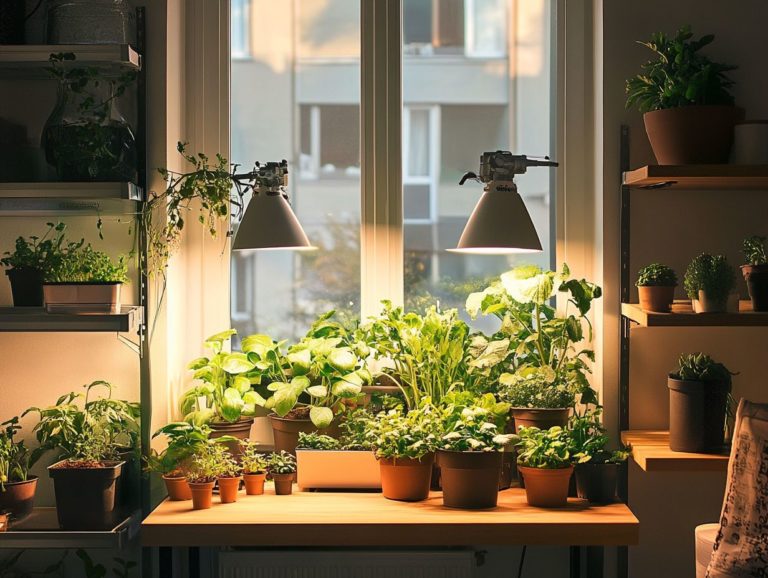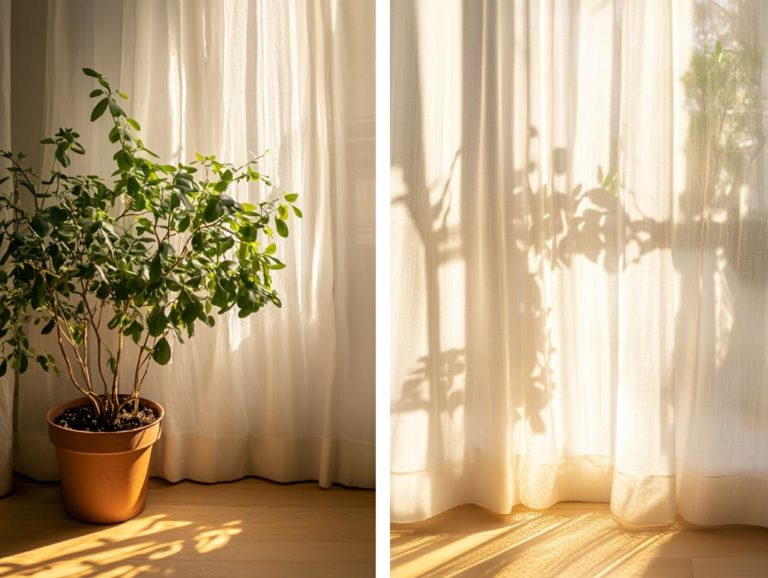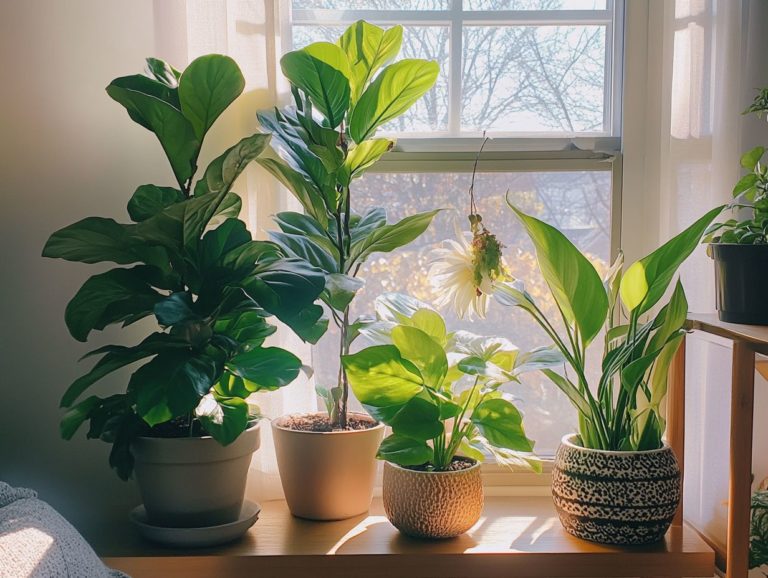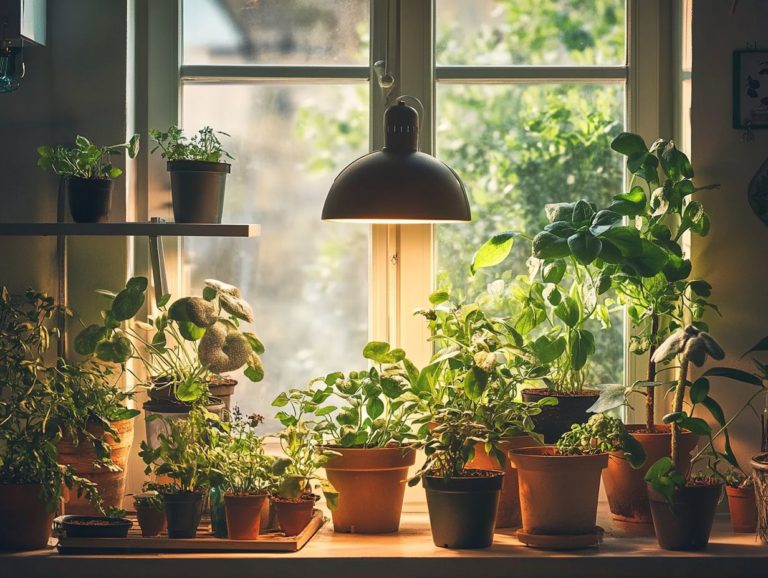How to Keep Track of Plant Light Needs
Understanding the light needs of your indoor plants is crucial for their growth and overall vitality. This article explores the factors that influence light requirements and helps you identify the optimal light levels for your plants to thrive.
It examines the differences between natural and artificial lighting, compares various artificial light types, and guides you in crafting an effective lighting plan tailored specifically to your plants. You ll find tips for monitoring and adjusting light levels to ensure your plants receive just the right amount.
Jump in now and watch your indoor garden flourish!
Contents
- Key Takeaways:
- Understanding Plant Light Needs
- Identifying Light Levels
- Types of Plant Lighting
- Creating a Lighting Plan
- Monitoring and Adjusting Light Levels
- Frequently Asked Questions
- How do I determine the light needs of my plants?
- What are some signs that my plant is not getting enough light?
- How can I keep track of the amount of light my plant is receiving?
- Should I rotate my plants to ensure they receive adequate light?
- Can I use artificial light to meet my plant’s light needs?
- What are some common mistakes to avoid when keeping track of plant light needs?
Key Takeaways:
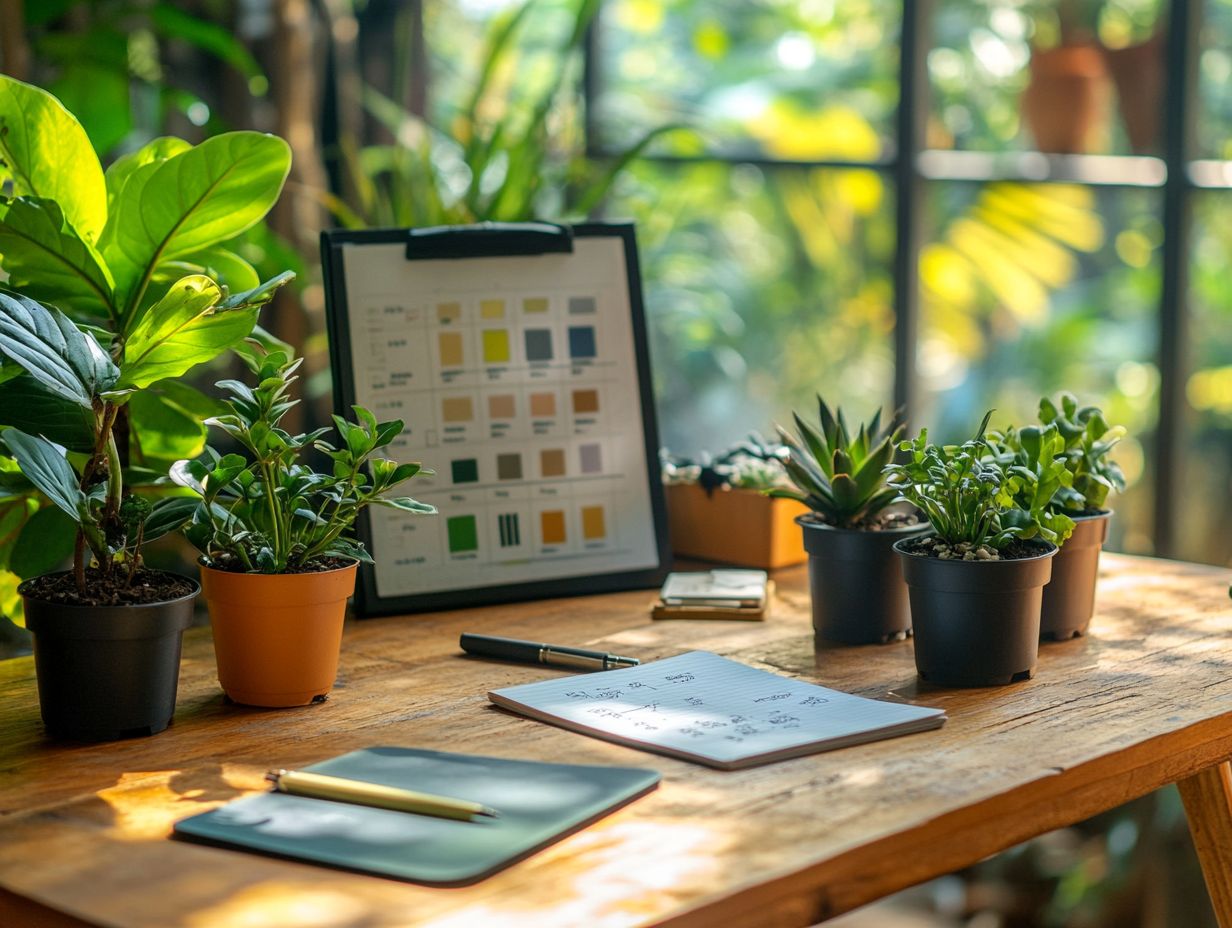
- Understand the factors that affect a plant’s light needs, such as type, species, and stage of growth.
- Use a light meter, a tool to measure how much light your plants get, to accurately assess light intensity.
- Create a lighting plan by matching your plants light needs with the type and intensity of light they require. Make adjustments for seasonal changes and light duration.
Understanding Plant Light Needs
Understanding the light needs of your indoor plants is essential for ensuring their thriving growth and overall well-being. Each houseplant variety, whether it’s the ZZ Plant, Fiddle Leaf Fig, or Norfolk Island Pine, has unique light requirements that significantly impact its health and vitality, including the need for direct or indirect sunlight.
By assessing the light levels in your space ranging from high light to medium and low light conditions you can make informed decisions about where to place each plant. Tailoring your care routines ensures that every plant receives the optimal amount of sunlight exposure it craves, promoting effective plant acclimation.
Factors Affecting Light Requirements
Several factors influence the light requirements of your indoor plants, including light intensity, duration, and quality. These elements are crucial for their overall health, especially in how plants make food using sunlight.
For example, seasonal changes can dramatically affect light levels and determine how well your plants thrive indoors. During fall and winter, shorter days may lead to decreased quality and intensity of light, causing potential issues like stunted growth and increased vulnerability to diseases and pests.
Inadequate lighting doesn t just impede photosynthesis; it also creates a welcoming environment for pests. Stressed plants are less equipped to defend themselves against these threats. It s crucial to understand the specific watering needs of each plant variety, as overwatering can lead to root rot and complications that hinder proper growth.
Identifying Light Levels
Identifying light levels is vital for determining the optimal placement of your indoor plants. Each plant thrives under specific conditions, whether basking in direct sunlight or flourishing in low-light environments.
By understanding these nuances, you can create the ideal setting for your greenery to thrive.
Measuring Light Intensity
Measuring light intensity with precision is essential for success in indoor gardening. Using tools like a light meter allows you to accurately assess the sunlight hours your plants receive.
Understanding different plants specific light needs helps you cater to their unique requirements, ensuring each variety gets the optimal amount of light for robust growth. This is where maintaining a plant tracker becomes essential; it helps you monitor light exposure and growth patterns over time.
Light intensity directly influences the rate of photosynthesis, impacting overall plant growth rates. When plants receive insufficient light, their growth can stagnate, leading to weaker structures, fewer flowers, and diminished yields. This is particularly concerning for those interested in succulent care. Therefore, effective measurement and tracking of light can significantly enhance the success of your indoor garden.
Types of Plant Lighting
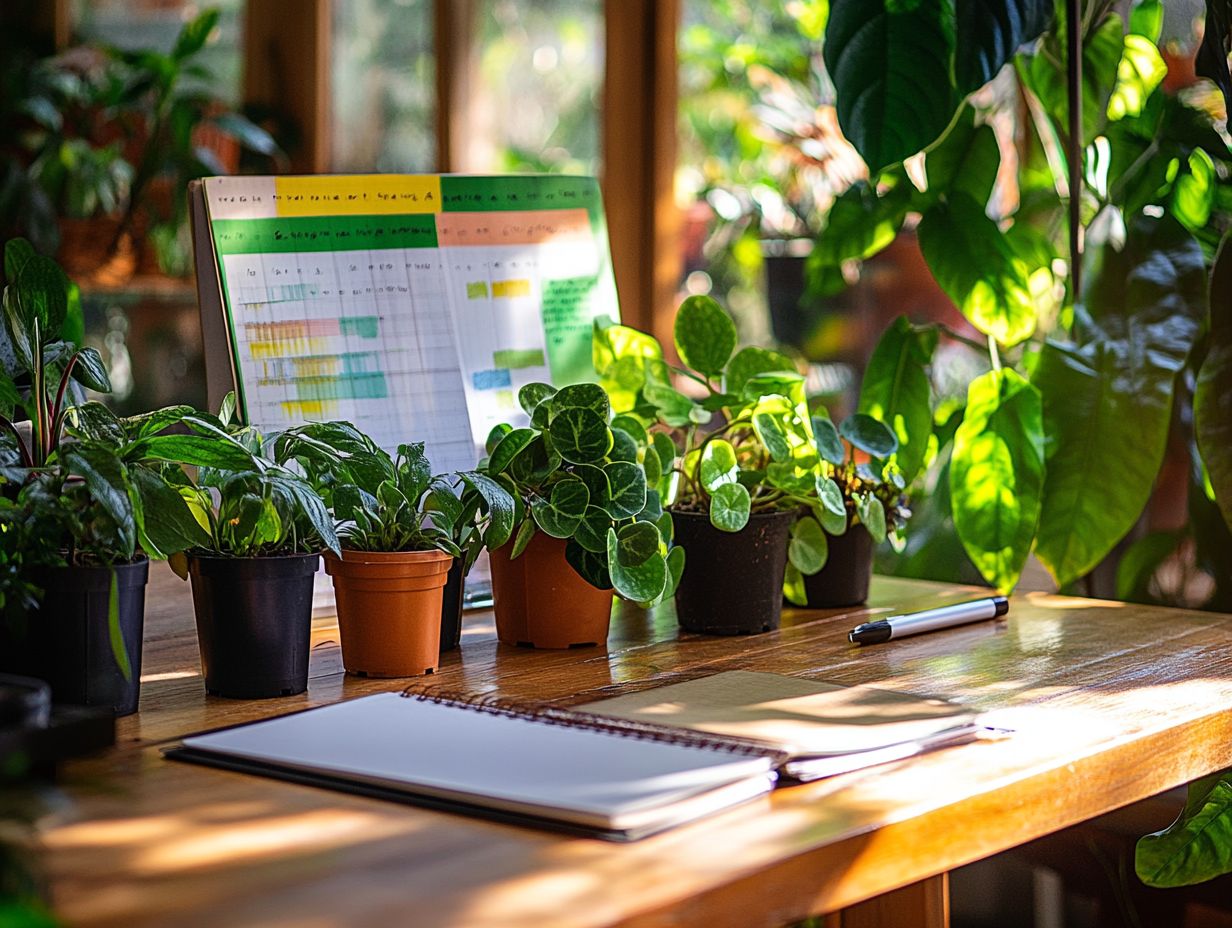
Grasping the various types of plant lighting available, including artificial lighting options like grow lights, is essential for cultivating a successful indoor gardening environment. Both natural light and artificial lighting significantly influence the health and vitality of your plants.
Natural vs Artificial Light
Natural light offers the most genuine conditions for plant growth. When sunlight is scarce, you can turn to artificial lighting, like grow lights, to enhance the ambient light in your space.
This essential balance fosters flourishing indoor environments brimming with lush greenery. Natural light provides essential wavelengths for making food from sunlight, nurturing robust leaf development and vibrant hues in various houseplants, such as snake plants and pothos.
When natural light falls short, artificial lights can emulate these conditions, allowing even low-light plants to receive consistent, customized exposure. However, while artificial lighting has its benefits, overdoing it can lead to phototropism, which is when plants bend towards light and can cause poor growth if they are overexposed.
Therefore, understanding how different types of light affect plant health is crucial for achieving optimal results in indoor gardening.
Comparing Different Types of Artificial Light
When it comes to artificial lighting, comparing different types like LED lights and fluorescent lights can guide you in selecting the best options for your indoor plants.
Understanding light quality is critical, as it directly affects how effectively your plants make food from sunlight and grow. For instance, LED lights provide an adjustable spectrum tailored to meet the specific needs of various plant species, fostering healthier leaf production and brilliant blooms.
On the other hand, fluorescent lights emit a broader spectrum but might not deliver the intensity that light-hungry varieties crave. Certain plants, such as succulents and cacti, thrive under strong, full-spectrum LEDs, while leafy greens tend to flourish with mid-range fluorescent tubes.
- Succulents: Prefer strong, full-spectrum LED light.
- Leafy Greens: Thrive under mid-range fluorescent tubes.
Recognizing these differences is vital for crafting an optimal environment for your indoor garden.
Creating a Lighting Plan
Crafting a lighting plan for your indoor garden is essential, especially when considering the specific light conditions and requirements of your various houseplant varieties. It ensures that each plant receives the precise sunlight exposure it requires, tailored to its individual needs, which is vital for optimal houseplant care.
Matching Light Needs with Plant Types
Matching light needs with specific plant types promotes healthy growth, ensuring that your houseplants, like the Rubber Tree and Peace Lily, receive the ideal light conditions.
For example, succulents flourish in bright, direct sunlight, while ferns prefer low to moderate light. Understanding these distinctions allows you to cultivate an environment that meets the unique requirements of each plant, including knowing how to measure light intensity for plants.
When selecting houseplants, assess the natural light available in various areas of your home. South-facing windows offer abundant light for sun-loving species, while north-facing spots are better suited for shade-tolerant varieties.
Don’t forget to rotate your plants occasionally to guarantee they receive balanced light exposure. This simple practice can prevent uneven growth and keep their foliage looking vibrant and healthy.
Get ready to transform your indoor garden into a lush paradise! Start planning your lighting setup today by understanding indoor plant light needs for thriving plants!
Tips for Providing Adequate Light
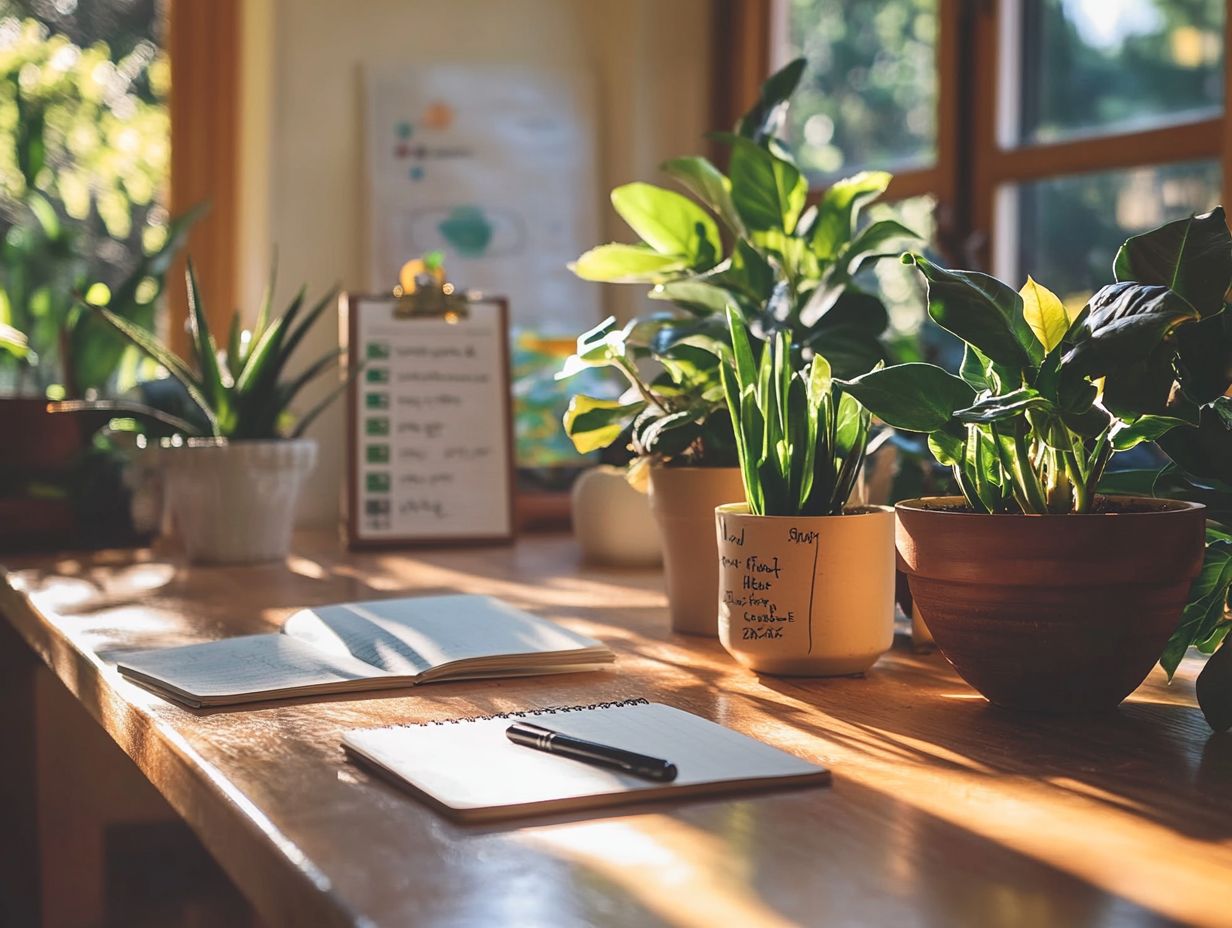
To provide your indoor plants with the light they need to flourish, consider these practical tips. They will help optimize their exposure and adapt to seasonal changes affecting their growth.
Rotate the pots regularly. This ensures that all sides of your plants receive equal sunlight, promoting balanced growth.
During the shorter days of winter, using grow lights can be particularly helpful. They mimic natural sunlight and provide the right spectrum for plants to make food from sunlight.
Be mindful of your watering schedules. New light exposure may dry out the soil faster, so adjust your moisture management to prevent over or under-watering.
By refining these care practices, including regular use of a plant journal, your indoor greens can thrive, even when natural light is scarce.
Monitoring and Adjusting Light Levels
Monitoring and adjusting light levels is crucial for successful indoor gardening. Changes in light conditions can significantly influence plant health and growth.
Pay attention to these factors. They help create an optimal environment for vibrant, thriving greenery.
Signs of Inadequate or Excessive Light
Recognizing signs of improper light is essential for your indoor plants. Symptoms can include leaf drop and leggy growth.
If leaves turn yellow and fall off, your plants may not be getting enough light. This leads to stunted growth and makes plants more vulnerable to pests.
If leaves look scorched or develop brown tips, that s a clear sign of too much light. Think of it as sunburn for your plants.
Slower growth or a lack of new leaves often points to insufficient lighting. Understanding the balance between light quantity and quality is vital for a thriving indoor garden.
How to Adjust Light Levels
Adjusting light levels can dramatically improve your plants growth and overall health. Focus on managing light exposure and plant placement.
Observe the natural light patterns in your home. If a plant is struggling, move it closer to a window or into brighter areas.
Using grow lights in dark corners or during cloudy months can be a game-changer. Keep an eye out for signs of stress or, even better, signs of exuberant growth.
Seasonal adjustments and consistent monitoring will ensure your indoor garden flourishes all year.
Frequently Asked Questions
How do I determine the light needs of my plants?
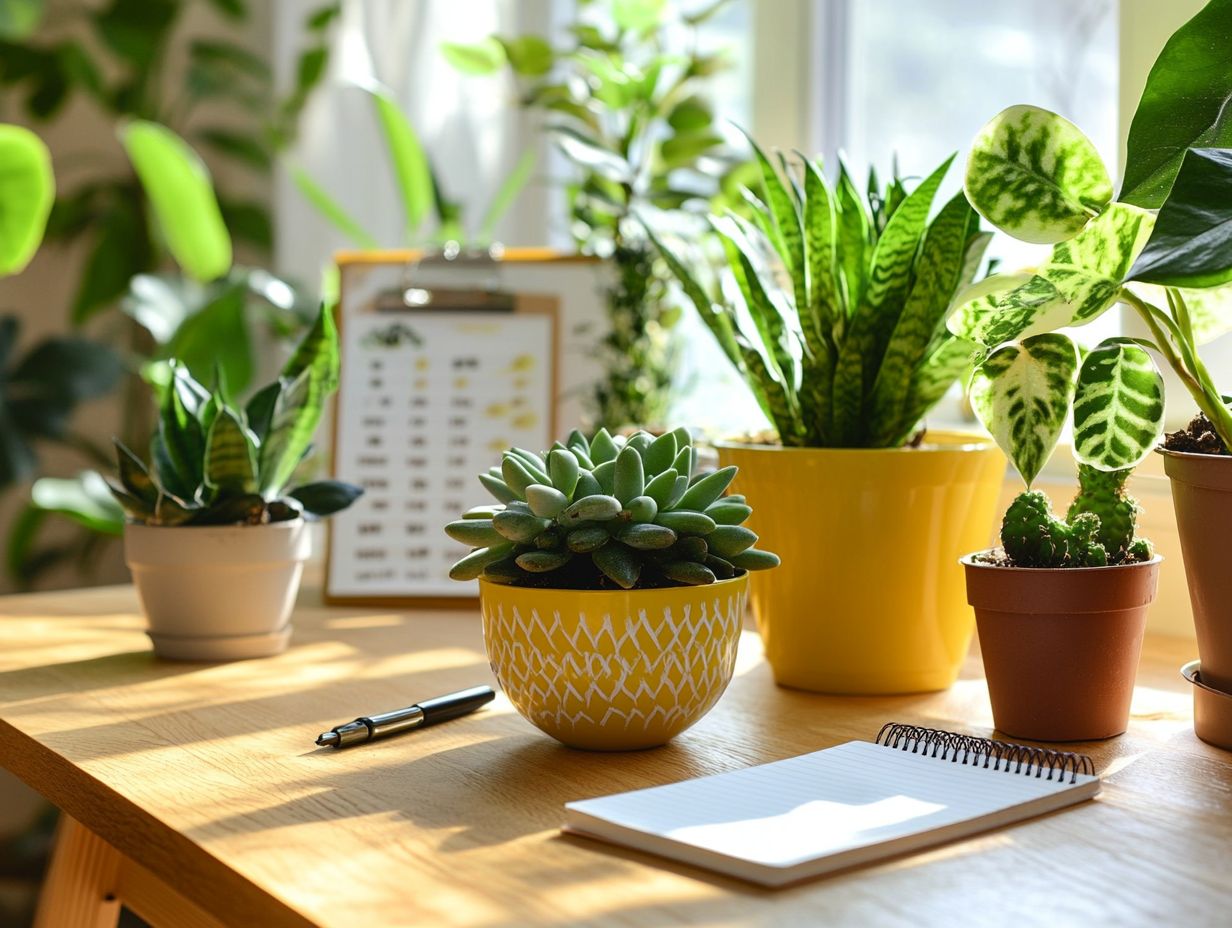
To find out what your plants need, check the reference data or do a quick search. Usually, plants fall into low, medium, or high light categories based on their natural habitats.
What are some signs that my plant is not getting enough light?
Stunted growth, yellowing leaves, and leaning towards a light source are signs your plant isn’t getting enough light. If you see these symptoms, adjust your plant’s lighting right away!
How can I keep track of the amount of light my plant is receiving?
One way to track your plant’s light exposure is to use a light meter. This device measures how bright an area is, helping you see if your plant is getting enough light.
You can also note how many hours of light your plant gets each day.
Should I rotate my plants to ensure they receive adequate light?
Yes, rotating your plants helps them get even light on all sides. This is key for plants that lean toward their light source.
Regular rotations encourage balanced growth and keep your plants looking healthy.
Can I use artificial light to meet my plant’s light needs?
Absolutely! You can use grow lights to provide the right amount of light for your plants. Just choose the right type and intensity for your specific plant.
Keep an eye on how long you use the artificial light; both too much and too little can harm growth.
What are some common mistakes to avoid when keeping track of plant light needs?
A big mistake is thinking all plants have the same light needs. Research the specific needs of each plant in your collection!
Not adjusting light exposure as the seasons change is another mistake. Regularly check and adjust light levels to support healthy growth.


